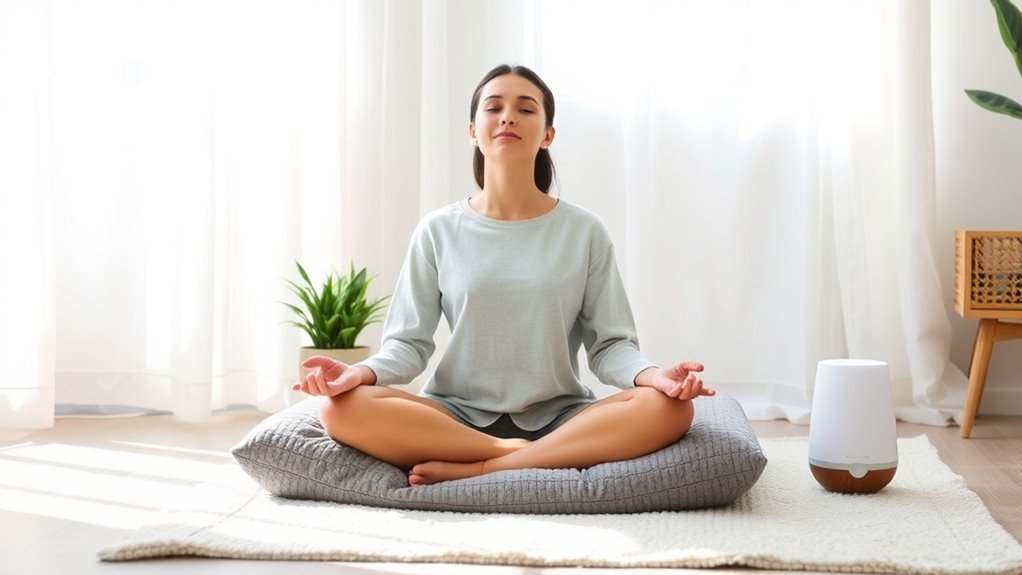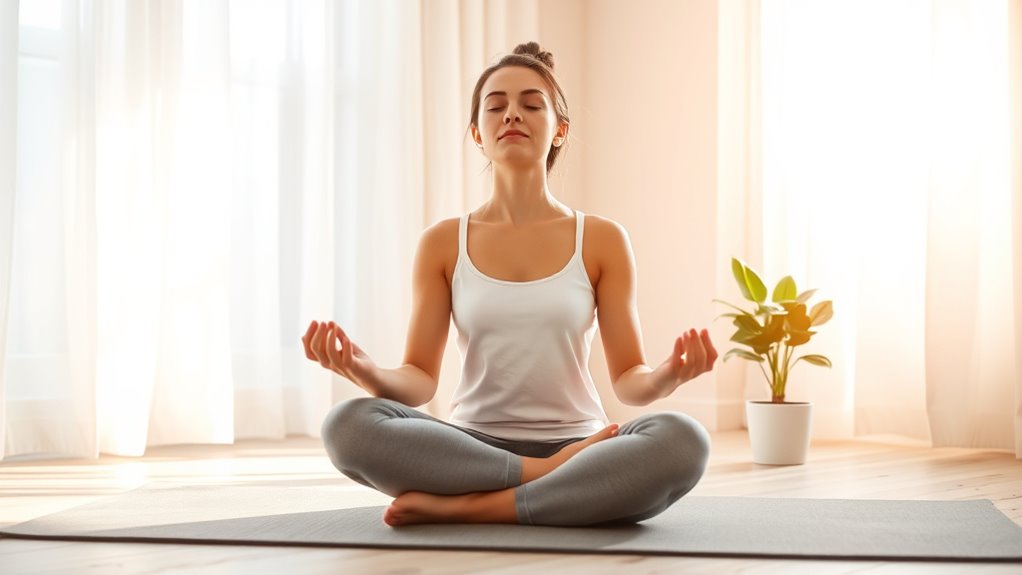When experiencing a panic attack, try calming breathing exercises to reduce symptoms. Techniques like deep diaphragmatic breathing, the 4-7-8 method, and box breathing can slow your heart rate, relax your nervous system, and shift your focus away from distressing thoughts. Incorporating mindfulness and visualization further enhances your control. Practicing these regularly helps build resilience over time. Keep exploring ways to improve your breathing habits to better manage panic episodes when they occur.
Key Takeaways
- Practice deep diaphragmatic breathing to slow heart rate and reduce panic symptoms during attacks.
- Use the 4-7-8 breathing method for quick relaxation and stress reduction.
- Incorporate box breathing techniques to regulate breath and calm the nervous system.
- Combine guided visualization with controlled breathing to divert attention from panic triggers.
- Maintain regular practice to strengthen emotional regulation and improve response to anxiety episodes.
Understanding the Benefits of Breathing Exercises During Panic Attacks

When a panic attack hits, breathing exercises can be a powerful tool to help you regain control. They promote stress reduction by calming your nervous system, which often becomes overwhelmed during an attack. Proper breathing techniques help you slow down rapid heartbeats and shallow breaths, reducing feelings of panic. Additionally, focusing on your breath enhances emotional regulation, allowing you to stay centered amid chaos. This mental focus shifts your attention away from distressing thoughts and physical sensations, fostering a sense of calm. Over time, consistent practice strengthens your ability to manage anxiety triggers more effectively. Breathing exercises serve as an accessible, immediate way to soothe your mind and body, empowering you to face panic attacks with greater confidence. Practicing mindfulness can further improve your resilience and overall emotional well-being during stressful moments.
Deep Diaphragmatic Breathing Techniques

Deep diaphragmatic breathing is a highly effective technique to enhance the calming effects of your breathing exercises. It encourages you to breathe deeply into your diaphragm, promoting better oxygen exchange and improving respiratory health. Focus on slow, steady breathing patterns, inhaling through your nose, and expanding your belly. This method reduces stress and stabilizes your heartbeat during panic attacks. To understand its significance, consider this table:
| Breathing Pattern | Effect on Respiratory Health | Mind-Body Connection |
|---|---|---|
| Slow, deep breaths | Strengthens lung capacity | Promotes relaxation |
| Controlled inhalation | Enhances oxygen flow | Reduces anxiety |
| Diaphragmatic focus | Improves breathing efficiency | Builds mindfulness |
| Consistent practice | Supports respiratory health | Fosters calmness |
| Gentle exhalation | Clears residual tension | Reinforces stress relief |
Additionally, engaging in mindfulness practices during diaphragmatic breathing can further amplify its calming benefits.
The 4-7-8 Breathing Method for Immediate Calm

The 4-7-8 breathing method provides a quick and effective way to calm your nerves during a panic attack. By focusing on controlled breathing, you can reduce stress levels and promote relaxation instantly. This technique helps slow your heart rate, easing feelings of anxiety and panic. Plus, it’s known to improve sleep quality over time, making it easier to fall asleep peacefully. To practice, breathe in through your nose for four seconds, hold the breath for seven seconds, then exhale slowly through your mouth for eight seconds. Repeating this cycle a few times can bring immediate relief. Incorporating this method into your daily routine can also support mental health and ongoing stress reduction, especially when anxiety strikes unexpectedly.
Box Breathing: A Structured Approach to Anxiety Relief

Box breathing offers a simple, effective way to manage anxiety by controlling your breath in a structured pattern. You’ll learn the technique, its benefits, and how to practice it step-by-step. With consistent effort, you can make this calming exercise a reliable tool during stressful moments. Practicing box breathing regularly can also strengthen your resilience against everyday stressors.
Technique Overview and Benefits
When you practice box breathing, you follow a structured pattern that helps calm your nervous system and reduce anxiety quickly. This technique works by regulating your breath, which can counteract the physical effects of panic attack triggers. Its history dates back to military and meditative practices, emphasizing focus and control. The benefits include lowering stress levels, improving emotional resilience, and providing a quick calming effect during heightened anxiety. By maintaining a consistent rhythm, you can break the cycle of rapid, shallow breaths that often accompany panic attacks. Regular practice strengthens your ability to manage sudden anxiety episodes, making it easier to regain composure. Overall, box breathing offers a practical, easy-to-learn method to soothe your mind and body during stressful moments. Incorporating mindful breathing exercises into your routine can further enhance your overall mental well-being and resilience against stress.
Step-by-Step Practice Guide
To effectively incorporate box breathing into your anxiety management routine, follow this step-by-step guide. Begin by inhaling slowly through your nose for a count of four, focusing on your breath. Hold that breath for a count of four, keeping your mind calm. Then, exhale steadily through your mouth for four counts, releasing tension. Finally, pause and hold your breath out for four counts before starting the next cycle. Repeat this breathing pattern consistently to help regulate your stress response. Consistent practice of box breathing enhances its benefits and helps establish a routine. Box breathing promotes mindfulness and enhances stress management by anchoring your focus and controlling your breathing. As you practice regularly, you’ll find it easier to manage panic symptoms and reduce anxiety during stressful moments. Stick with the pattern, and over time, it can become a powerful tool in your anxiety relief toolkit.
Tips for Consistency
Establishing a routine is key to maintaining consistency with box breathing, so try to practice at the same time each day. Creating this habit helps reinforce habit formation and makes it easier to stick with your practice long-term. To boost your motivation strategies, set small, achievable goals and track your progress. Remember, consistency builds confidence and reduces anxiety over time. Incorporating best anime movies into your leisure time can also provide a positive mental boost that complements your breathing exercises.
Guided Visualization With Controlled Breathing

Guided visualization with controlled breathing helps you create a calming mental space, making it easier to manage panic symptoms. By using visualization techniques, you can focus your mind on peaceful scenes or positive imagery, reducing anxiety’s intensity. As you breathe slowly and deeply, imagine a safe, tranquil place—perhaps a quiet beach or lush forest—using mental imagery to enhance relaxation. This process redirects your attention away from panic triggers and toward calming visuals, helping you regain control. Combining controlled breathing with mental imagery strengthens your ability to stay present and composed during stressful moments. With practice, this technique becomes a powerful tool, enabling you to soothe your mind and body during panic attacks. Additionally, understanding city dynamics can help you develop routines that support your mental well-being in your environment.
Incorporating Mindfulness Into Your Breathing Practice

Building on the calming effects of visualization and controlled breathing, adding mindfulness into your practice can deepen your sense of calm and awareness. Mindfulness meditation encourages you to focus on the present moment, enhancing body awareness during each breath. As you breathe, notice the sensations in your body—where tension is held, how the air feels as it enters your lungs, and the rise and fall of your chest. This heightened awareness helps you stay grounded during a panic attack, reducing feelings of overwhelm. To deepen your practice, consider:
Enhance calm by focusing on bodily sensations and observing thoughts without judgment during mindful breathing.
- Paying close attention to physical sensations during each breath
- Observing thoughts without judgment
- Using gentle reminders to return focus to your body and breath
- Incorporating mindfulness techniques to further enhance your practice
Incorporating mindfulness makes your breathing exercises more effective by fostering a non-judgmental awareness.
Tips for Practicing Breathing Exercises Regularly

Practicing breathing exercises regularly can considerably improve your ability to manage panic attacks, but consistency is key. Establishing a routine helps reinforce effective breathing patterns and relaxation techniques. To stay committed, set aside specific times each day, such as morning or evening, and create a calming environment. Use reminders, like alarms or sticky notes, to reinforce your practice. Remember, even a few minutes daily can make a difference. Focus on calming your mind and slow, deep breaths. Incorporate different relaxation techniques, like diaphragmatic breathing or box breathing, to keep your practice engaging. Here’s a quick overview:
| Tip | Why it helps | Example |
|---|---|---|
| Schedule daily | Builds habit | Morning meditation |
| Use reminders | Maintains consistency | Phone alarms |
| Vary techniques | Prevents boredom | Different breathing patterns |
| Create a calm space | Reinforces relaxation | Quiet corner |
| Maintain color awareness | Enhances mindfulness during exercises | Focus on breath with visual cues |
Frequently Asked Questions
Can Breathing Exercises Replace Medication for Panic Attacks?
You might wonder if breathing exercises can replace medication for panic attacks. While they serve as effective medication alternatives and can reduce symptoms, they often work best when combined with therapy integration. Breathing techniques help manage immediate symptoms, but for long-term control, consulting a healthcare professional is essential. Relying solely on breathing exercises isn’t enough for everyone, so consider a thorough treatment plan tailored to your needs.
How Long Should I Practice Breathing Exercises Daily?
Think of practicing breathing exercises like watering a plant—you’ll see growth with consistency. You should aim for about 10-15 minutes daily, but the key is practice consistency and tracking progress. I once started with just five minutes, and over weeks, I noticed calmer moments during stress. Stick with it daily, gradually increasing as you feel comfortable, and you’ll build resilience against panic attacks.
Are There Any Risks or Contraindications for Certain Breathing Techniques?
You might wonder about risk factors or contraindication warnings when practicing breathing techniques. Generally, these exercises are safe, but if you have respiratory issues, heart problems, or anxiety disorders, consult your healthcare provider first. Avoid techniques that cause dizziness, shortness of breath, or discomfort. Always listen to your body and stop if you experience adverse effects. Being aware of contraindications guarantees you practice safely and effectively.
Can Children Effectively Use These Breathing Exercises?
You might wonder if children can effectively use breathing exercises. With proper child adaptation and considering age considerations, most kids can learn simple techniques like deep breathing or counting breaths. Younger children may need guidance and visual cues to stay engaged, but these exercises can help them manage stress and anxiety. Just guarantee the techniques are age-appropriate and practiced with patience, making it easier for children to benefit from them.
What Should I Do if a Breathing Exercise Triggers Dizziness?
If a breathing exercise causes dizziness, you should stop immediately to prevent discomfort. Focus on dizziness management by sitting or lying down to stabilize yourself. Try adjusting your breathing technique by slowing your inhale and exhale, or using a less intense method like diaphragmatic breathing. Always listen to your body, and if dizziness persists, consult a healthcare professional to make sure you’re practicing safe and effective breathing techniques.
Conclusion
By mastering these breathing exercises, you hold the power to tame panic attacks like a superhero wielding a calmness storm. Regular practice transforms your breath into a mighty shield against anxiety, turning chaos into calm in seconds. Remember, your breath is your secret weapon—use it wisely and watch panic shrink to a tiny speck, no bigger than a pinhead. With each breath, you’re unstoppable in conquering anxiety and reclaiming your peace.









